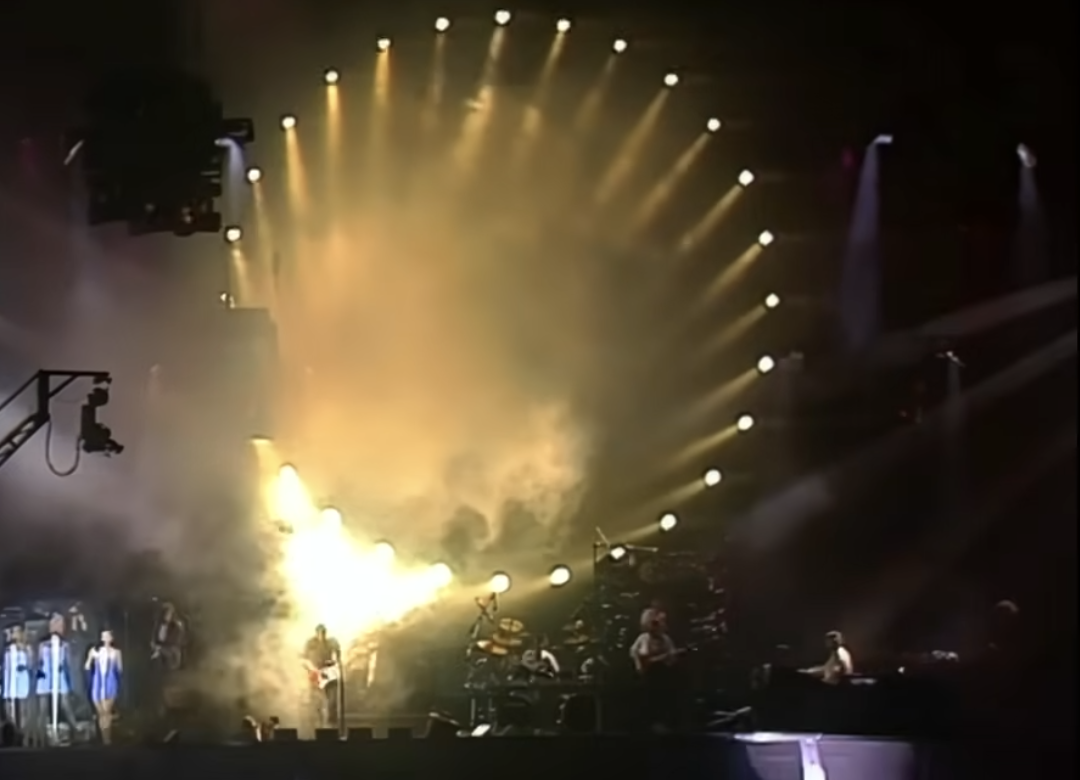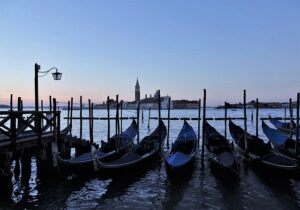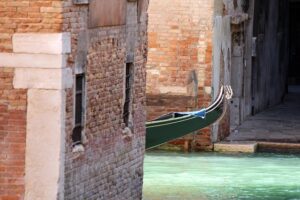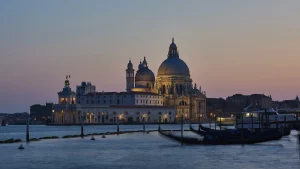Pink Floyd in Venice: The Concert That Shook a City 🌊
When rock met Renaissance, the results were anything but quiet.
On July 15, 1989, Venice witnessed one of the most extraordinary—and controversial—concerts in modern history. What was meant to be a celebration of music and European unity became a cultural earthquake that would shake the foundations of City Hall itself. Pink Floyd’s legendary “Concert for Europe” wasn’t just a performance—it was a moment that tested how far art could go in a city built on water, beauty, and fragile balance.
Even now, more than three decades later, the echoes of that night still ripple through Venice’s canals. The event remains a cautionary tale about the collision between spectacle and preservation—between a city’s need to stay alive and its duty to protect its soul.
The Floating Stage That Changed Everything
The idea was outrageous, audacious—and very Venetian. Italian promoter Francesco Tomasi dreamed up the vision: bring Pink Floyd to Venice for a free concert on a floating stage in the Grand Canal. The setting? Between the iconic twin columns of St. Mark’s Square, with San Giorgio Maggiore rising like a dream behind it.
The stage itself was essentially a converted oil rig—a marvel of engineering that allowed the band to perform amid one of the world’s most fragile and historic skylines. It was a breathtaking contrast: laser lights against marble domes, rock anthems echoing off centuries-old façades, and a city that seemed to float between two worlds—the ancient and the electric.
Pink Floyd, performing without Roger Waters for the first time in Italy, took the stage as a trio—David Gilmour, Nick Mason, and Richard Wright—supported by backing musicians. The plan was simple: music as a gift to Europe, Venice as the stage, and history as the audience. But history had other ideas.
A Night of Wonders
That July night drew an estimated 200,000 people to Venice. Locals, tourists, and fans poured in from across Europe. Some came by train, others by boat, many by sheer luck. Television crews set up everywhere; the concert was broadcast live to more than 100 million viewers worldwide. For a brief, dazzling moment, the whole of Europe had its eyes on the floating city.
Pink Floyd delivered what the press later called a “Notte dei Miracoli”—a Night of Wonders. The setlist was pure magic: Shine On You Crazy Diamond, Comfortably Numb, Money, and Another Brick in the Wall. As the music soared, lights reflected off the water, bouncing across the facades of palazzi and churches. The Grand Canal itself became part of the performance.
Venice had never seen anything like it. And it never would again.
The Morning After: Beauty Meets Chaos
Then came the morning. St. Mark’s Square—the heart of Venice—looked like a battlefield. Trash, beer cans, and sleeping fans filled every corner. Lamp posts were bent where people had climbed for a better view. Monuments were used as makeshift toilets. The air smelled like stale wine and regret.
For Venetians, it wasn’t just about the mess—it was about respect. Their city, already struggling with crowds and fragility, had been treated like a stage prop. That night became a symbol of what happens when mass tourism and preservation collide—a theme that Venice still wrestles with today. (See our feature on overtourism and its impacts.)
Damage was minor in technical terms, but massive in perception. The floating city, proud of its dignity and centuries-old heritage, woke up humiliated.
Political Fallout: A Government Falls
Within days, the concert sparked a political storm. Enraged residents flooded the city council with complaints. Venice’s mayor at the time, Antonio Casellati, was accused of turning a UNESCO World Heritage site into an “open-air nightclub.” Newspapers ran scathing headlines. Locals demanded resignations. They got them.
On July 24—just nine days after the concert—the entire municipal government stepped down. The event became not just a scandal, but a turning point. Even Italy’s Parliament debated it, with national leaders questioning whether cultural heritage should ever be used for mass entertainment again.
It was official: Pink Floyd had literally brought down a government.
Rock vs. Heritage: The Debate That Never Ended
The 1989 concert forced Venice—and the world—to confront a painful truth: how does a historic city survive in the modern age?
Venice had long struggled with its double identity. On one side, a living city of residents and traditions. On the other, an open-air museum visited by millions. The concert amplified this tension like a feedback loop. Should Venice host spectacular cultural events that bring global attention, or protect itself from the very fame that threatens its survival?
Even today, the question remains. You can see echoes of it in the city’s ongoing debates over climate change and flooding, or its efforts to control population decline and overdevelopment. The same tension that played out in 1989 still defines Venice’s future: a city that must evolve without erasing itself.
Mayor Casellati himself summarized it best before his resignation: “Venice must never again be exposed to these kinds of risks.” Those words became prophetic—and still guide city policy today.
Legacy of the Concert
Despite the chaos, the Pink Floyd concert became a part of Venice’s myth. The footage from “Pink Floyd: Live in Venice” remains stunning—music rising from the water, the skyline bathed in color, the crowd swaying in silhouette. For fans, it was pure magic. For locals, it was heartbreak wrapped in sound and light.
And yet, the event taught Venice invaluable lessons about preservation and resilience. It inspired new discussions about how to balance art, tourism, and cultural integrity—conversations that continue to this day.
From that moment forward, large-scale events in Venice were carefully regulated. No more uncontrolled crowds, no more massive sound systems vibrating against Gothic walls. Instead, Venice embraced smaller, curated experiences—art biennales, classical performances, and guided events that celebrate rather than overwhelm. (See also Venice Beyond the Biennale.)
Venice Today: The Lessons That Stuck
More than 30 years later, the legacy of 1989 still shapes modern Venice. The city continues to wrestle with overtourism, cruise ship access, and the balance between economic vitality and cultural preservation. In 2025, Venice introduced an entry fee for day visitors—a measure designed to prevent exactly the kind of overload that defined that fateful concert night.
At the same time, Venice has become a global symbol of adaptation. From the MOSE flood barrier project to local conservation efforts, the city now fights daily to safeguard its beauty and community. The floating stage of 1989 may be gone, but its shadow still looms large over how Venice handles culture, tourism, and sustainability.
For Modern Visitors: A Different Kind of Music
Today, visitors can still stand where that floating stage once drifted, between St. Mark’s Square and San Giorgio Maggiore, and imagine the moment when Pink Floyd’s guitar solos echoed across the lagoon. The view is the same—the beauty, eternal—but the approach is wiser.
Modern Venice invites travelers to experience its rhythm differently. Take a quiet boat tour of the Grand Canal. Explore Sant’Elena and San Pietro di Castello, where Venetians still hang laundry and chat across courtyards. Or enjoy the kind of live music Venice is best suited for now—a string quartet at the Vivaldi concert in San Vidal Church or a baroque performance at the Scuola Grande di San Teodoro.
Venice doesn’t need amplifiers anymore. It hums on its own frequency—the sound of lapping water, distant bells, and history that refuses to fade.
Conclusion: The Night That Changed Everything
The 1989 Pink Floyd concert in Venice remains one of the most talked-about nights in rock history—a breathtaking fusion of music, politics, and chaos. It was both a triumph and a tragedy: proof of what happens when the power of art meets the fragility of heritage.
For Venice, that night was more than entertainment—it was a wake-up call. A lesson in limits. A reminder that this city, suspended between sea and sky, is not indestructible.
As you wander through St. Mark’s or cross the bridges near the Grand Canal, take a moment to imagine the stage lights reflecting off the lagoon and the crowd’s roar bouncing between marble walls. It was the night Venice learned that beauty and preservation must always play in harmony.
Want to discover how Venice balances its magic today?
Explore our guides to sustainable travel, daily life in Venice, and the city’s ongoing restoration efforts. Or join a private walking tour to see how locals keep the real Venice alive.
Because in Venice, even rock ’n’ roll becomes part of history.
FAQs
What happened during the Pink Floyd concert in Venice in 1989
On July 15, 1989, Pink Floyd performed a free concert on a floating stage in front of St. Mark’s Square. Over 200,000 people attended, and more than 100 million watched live on TV. The show became legendary—but also infamous—after the city was left littered and damaged, sparking outrage and leading to the resignation of Venice’s mayor and city council. It remains one of the most controversial cultural events in Venetian history.
Why was the Pink Floyd concert in Venice so controversial
The concert symbolized the clash between modern spectacle and heritage preservation. While the performance was visually stunning, the aftermath—widespread litter, property damage, and public disorder—was seen as disrespectful to Venice’s cultural heritage. The political fallout was immediate, forcing the city to reconsider how it handles large-scale events in its fragile historic center.
Can visitors still experience music in Venice today
Yes—but in a more intimate and sustainable way. Instead of massive outdoor concerts, Venice now celebrates music through smaller, elegant venues. Travelers can enjoy a Vivaldi Concert at San Vidal Church, a Baroque Concert at Scuola Grande di San Teodoro, or explore Venice’s quieter beauty on a Private 1-Hour Boat Tour or a Venice Cicchetti & Wine Tour. These experiences capture Venice’s true rhythm—graceful, timeless, and deeply musical.







